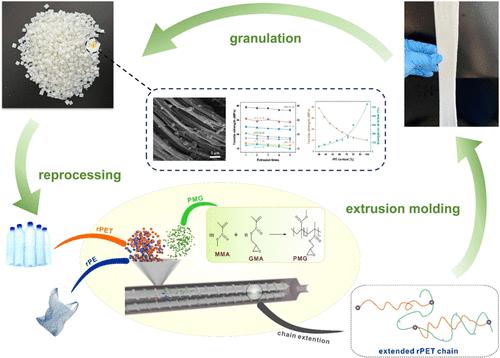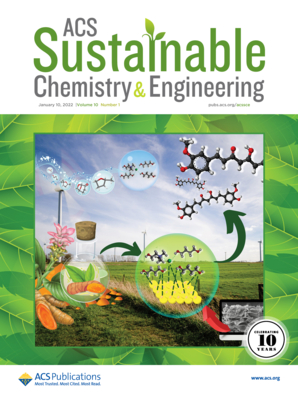Leveraging a Dynamic Physical Cross-Linking Architecture to Enable Recycled PET with Exceptional Thermoplasticity and Toughness
IF 7.3
1区 化学
Q1 CHEMISTRY, MULTIDISCIPLINARY
引用次数: 0
Abstract
The recycling of poly(ethylene terephthalate) (PET) is vital for environmental sustainability, yet achieving recycled PET (rPET) and its composites with optimal processability and flexibility remains a challenge. This study presents a solvent-free reactive extrusion method to extend the chains of rPET using a macromolecular chain extender (i.e., methyl methacrylate-glycidyl methacrylate copolymer, marked as PMG) rich in epoxy groups and to produce rPET/recycled polyethylene (rPET/rPE) composites. The resulting composites exhibit excellent thermoplasticity and controllable mechanical properties, such as the rPET/rPE composite (70:30 by mass), with a tensile strength of 39.2 MPa and an elongation at a break of 81.4%. After five extrusion cycles, their mechanical properties just encounter a subtle decline, indicating robust sustainability and cycle performance. The formation of a dynamic physical cross-linking network arises from the distinct polarity, hydrophobicity, and melt viscosity of rPET and rPE, where the hard spherical rPET phase is evenly dispersed in the soft rPE matrix with PMG acting as an interfacial compatibilizer. This innovative approach not only enhances the properties of the recycled composites but also promotes their cost-effectiveness and environmental benefits, thus broadening the potential applications of rPET and rPE as partial substitutes for virgin PET and PE.

利用动态物理交联架构,使再生PET具有卓越的热塑性和韧性
聚对苯二甲酸乙酯(PET)的回收利用对环境的可持续性至关重要,但如何使再生PET及其复合材料具有最佳的可加工性和柔韧性仍然是一个挑战。本研究提出了一种无溶剂反应挤出法,利用富含环氧基团的大分子扩链剂(即甲基丙烯酸甲酯-甲基丙烯酸缩水甘油酯共聚物,标记为PMG)延长rPET的链,制备rPET/再生聚乙烯(rPET/rPE)复合材料。复合材料具有优异的热塑性和可控的力学性能,如rPET/rPE复合材料(质量比为70:30),抗拉强度为39.2 MPa,断裂伸长率为81.4%。经过5次挤压循环后,其力学性能略有下降,具有较强的可持续性和循环性能。rPET和rPE具有不同的极性、疏水性和熔体粘度,形成了动态的物理交联网络,其中硬的球形rPET相均匀地分散在软的rPE基体中,PMG作为界面相容剂。这种创新的方法不仅提高了再生复合材料的性能,而且提高了它们的成本效益和环境效益,从而扩大了rPET和rPE作为原始PET和PE的部分替代品的潜在应用。
本文章由计算机程序翻译,如有差异,请以英文原文为准。
求助全文
约1分钟内获得全文
求助全文
来源期刊

ACS Sustainable Chemistry & Engineering
CHEMISTRY, MULTIDISCIPLINARY-ENGINEERING, CHEMICAL
CiteScore
13.80
自引率
4.80%
发文量
1470
审稿时长
1.7 months
期刊介绍:
ACS Sustainable Chemistry & Engineering is a prestigious weekly peer-reviewed scientific journal published by the American Chemical Society. Dedicated to advancing the principles of green chemistry and green engineering, it covers a wide array of research topics including green chemistry, green engineering, biomass, alternative energy, and life cycle assessment.
The journal welcomes submissions in various formats, including Letters, Articles, Features, and Perspectives (Reviews), that address the challenges of sustainability in the chemical enterprise and contribute to the advancement of sustainable practices. Join us in shaping the future of sustainable chemistry and engineering.
文献相关原料
公司名称
产品信息
阿拉丁
methyl methacrylate (MMA)
 求助内容:
求助内容: 应助结果提醒方式:
应助结果提醒方式:


